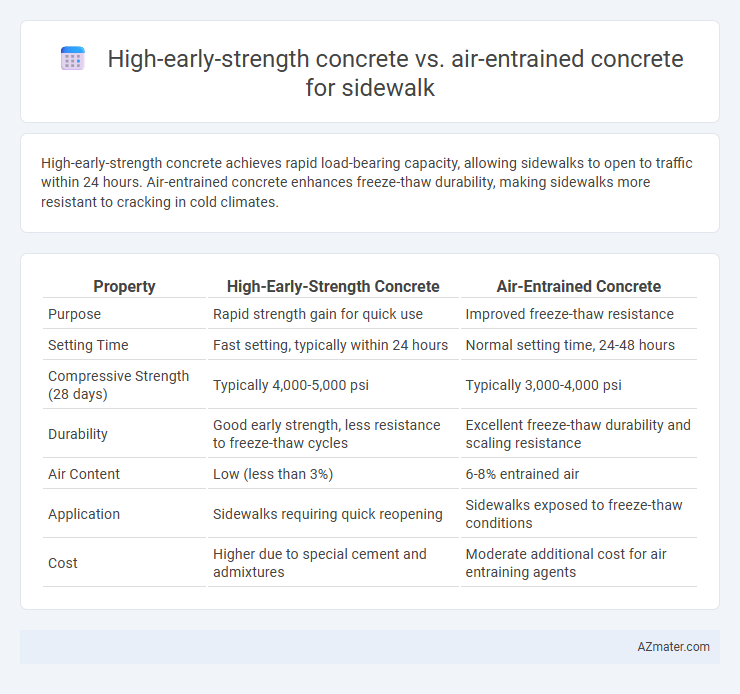High-early-strength concrete achieves rapid load-bearing capacity, allowing sidewalks to open to traffic within 24 hours. Air-entrained concrete enhances freeze-thaw durability, making sidewalks more resistant to cracking in cold climates.
Table of Comparison
| Property | High-Early-Strength Concrete | Air-Entrained Concrete |
|---|---|---|
| Purpose | Rapid strength gain for quick use | Improved freeze-thaw resistance |
| Setting Time | Fast setting, typically within 24 hours | Normal setting time, 24-48 hours |
| Compressive Strength (28 days) | Typically 4,000-5,000 psi | Typically 3,000-4,000 psi |
| Durability | Good early strength, less resistance to freeze-thaw cycles | Excellent freeze-thaw durability and scaling resistance |
| Air Content | Low (less than 3%) | 6-8% entrained air |
| Application | Sidewalks requiring quick reopening | Sidewalks exposed to freeze-thaw conditions |
| Cost | Higher due to special cement and admixtures | Moderate additional cost for air entraining agents |
Introduction to Sidewalk Concrete Types
High-early-strength concrete achieves rapid strength gain within hours, making it ideal for sidewalks requiring fast reopening and minimal downtime. Air-entrained concrete incorporates microscopic air bubbles that improve freeze-thaw durability and resistance to deicing chemicals, essential for sidewalks in cold climates. Selecting between high-early-strength and air-entrained concrete depends on project timelines and environmental exposure conditions to ensure long-lasting, safe pedestrian surfaces.
What is High-Early-Strength Concrete?
High-early-strength concrete is a type of concrete designed to achieve significant compressive strength within hours after pouring, often reaching 3,000 psi in 24 hours, which allows faster construction and early load-bearing capacity. This rapid strength gain is achieved through the use of high cement content, specific admixtures like calcium chloride, and optimized curing conditions, making it ideal for expedited sidewalk projects. In contrast, air-entrained concrete incorporates tiny air bubbles to improve freeze-thaw durability but does not prioritize rapid strength development.
Understanding Air-Entrained Concrete
Air-entrained concrete contains microscopic air bubbles incorporated through air-entraining admixtures, which improve its freeze-thaw durability, making it ideal for sidewalks exposed to harsh weather. High-early-strength concrete achieves rapid strength gain but lacks the enhanced durability against frost and deicing chemicals provided by air entrainment. Understanding air-entrained concrete's superior resistance to cracking and scaling is crucial for long-lasting sidewalk construction in cold climates.
Key Properties: Strength and Durability
High-early-strength concrete achieves compressive strengths above 3,000 psi within 24 hours, enabling faster project completion for sidewalks, while air-entrained concrete incorporates microscopic air bubbles that enhance freeze-thaw durability but typically gains strength at a standard rate. The high-early-strength mix excels in rapid load-bearing capacity but may be more susceptible to cracking under cyclic freezing and thawing without air entrainment. Air-entrained concrete, with its improved resistance to scaling and surface deterioration in cold climates, offers superior long-term durability despite slower strength development.
Performance in Cold Weather Conditions
High-early-strength concrete achieves rapid strength gain, enabling quicker walkability and reducing construction time in cold weather conditions. Air-entrained concrete incorporates microscopic air bubbles, enhancing freeze-thaw resistance and preventing surface scaling caused by ice formation. Combining these properties, air-entrained high-early-strength concrete offers superior durability and performance for sidewalks exposed to harsh winter climates.
Construction Speed and Project Timelines
High-early-strength concrete accelerates construction speed by reaching significant strength within 24 hours, enabling faster formwork removal and earlier opening of sidewalks, thus compressing project timelines. Air-entrained concrete improves durability and freeze-thaw resistance but typically gains strength at a standard rate, which may extend curing periods and delay subsequent construction phases. Prioritizing high-early-strength mixes supports expedited sidewalk completion, especially critical in projects with tight schedules or high pedestrian traffic demands.
Resistance to Freeze-Thaw Cycles
High-early-strength concrete achieves rapid curing, enhancing early load-bearing capacity but may exhibit lower durability under freeze-thaw cycles unless properly mixed. Air-entrained concrete incorporates microscopic air bubbles, significantly improving resistance to freeze-thaw damage by allowing space for water expansion during freezing. For sidewalks exposed to moisture and fluctuating temperatures, air-entrained concrete provides superior long-term durability compared to high-early-strength variants.
Cost Considerations and Budget Impact
High-early-strength concrete offers faster curing times, reducing labor and formwork costs, which can lead to lower overall project expenses for sidewalks requiring quick use. Air-entrained concrete enhances durability against freeze-thaw cycles but typically entails higher material costs due to admixtures, impacting the initial budget more significantly. Choosing between these concretes depends on balancing upfront costs with long-term performance needs and maintenance expenses in specific environmental conditions.
Recommended Applications for Sidewalks
High-early-strength concrete is recommended for sidewalks requiring rapid curing to minimize downtime, such as in busy urban areas or commercial zones where quicker pedestrian access is essential. Air-entrained concrete is preferred in regions experiencing freeze-thaw cycles, as the entrained air improves durability and resistance to scaling caused by ice formation. For sidewalks exposed to harsh weather conditions, combining high-early-strength with air-entrained properties can optimize both quick setting and long-term durability.
Conclusion: Choosing the Right Concrete for Sidewalks
High-early-strength concrete ensures rapid curing and early load-bearing capacity, ideal for projects requiring quick reopening of sidewalks, while air-entrained concrete enhances durability and freeze-thaw resistance critical in climates with harsh winters. Selecting the right concrete depends on project timelines, environmental conditions, and long-term performance needs; high-early-strength concrete suits fast-paced urban settings, whereas air-entrained concrete provides superior longevity and crack resistance in freeze-prone regions. For optimal sidewalk longevity and safety, balancing early strength requirements with environmental resilience dictates the concrete choice.

Infographic: High-early-strength concrete vs Air-entrained concrete for Sidewalk
 azmater.com
azmater.com